Review: Phoenix Gold RX2 10S
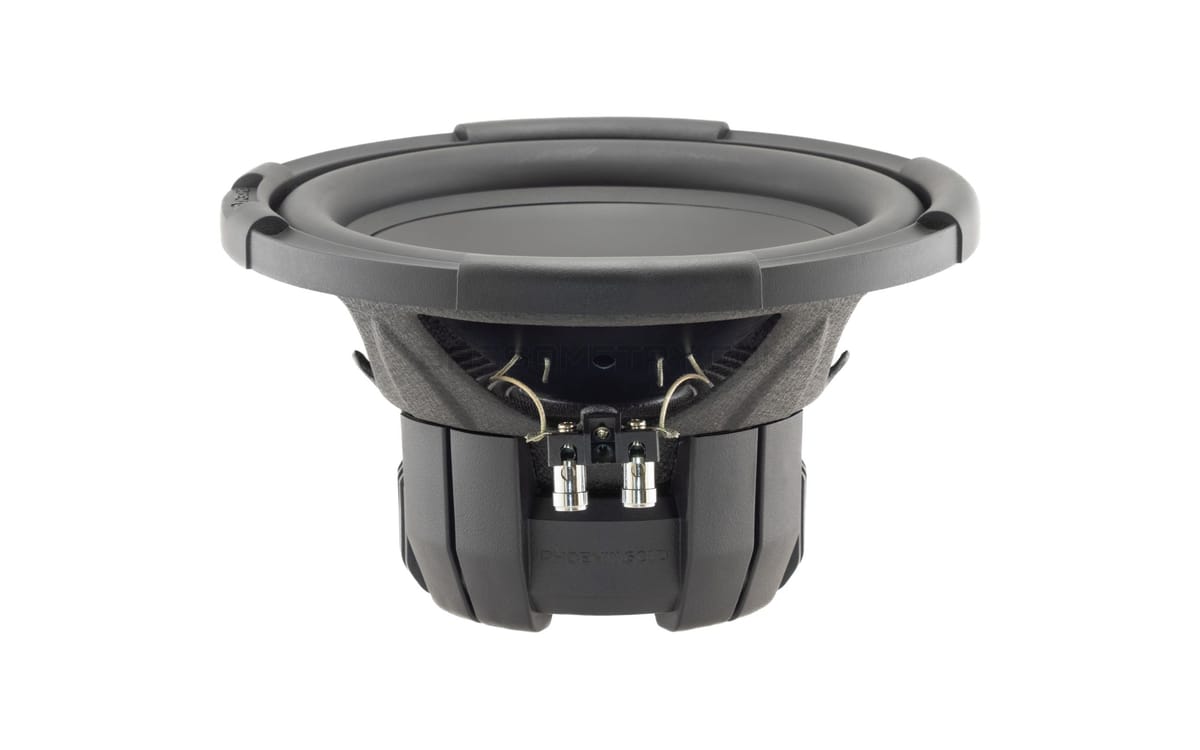
//In the works!
First blood: Phoenix Gold sub. Let’s shake it down.
Phoenix Gold is an American brand with global reach, known for producing a wide range of car audio equipment. The general consensus around the brand is positive, and at first glance, the RX2 10S holds its ground with solid features and competitive pricing. It looked good enough to purchase a piece for science and fun.
Looks and built quality:
Phoenix Gold markets this driver as an entry-level product. And while I’d agree with that classification, the presentation slightly exceeds expectations. The parabolic plastic cone, proudly marked with a large Phoenix Gold logo, looks and feels solid. The rubber surround, combined with basket with upper class finish elevates the aesthetic into mid-range territory. A full magnet cover wraps the motor structure cleanly, rounding off the design with a surprisingly premium feel to it. And yes, that surround is rubber—Phoenix Gold calls it “Phoeniroll” in their nomenclature. Rubber surrounds are usually a telltale sign of whether a manufacturer is cutting corners, but in this case, they didn’t.
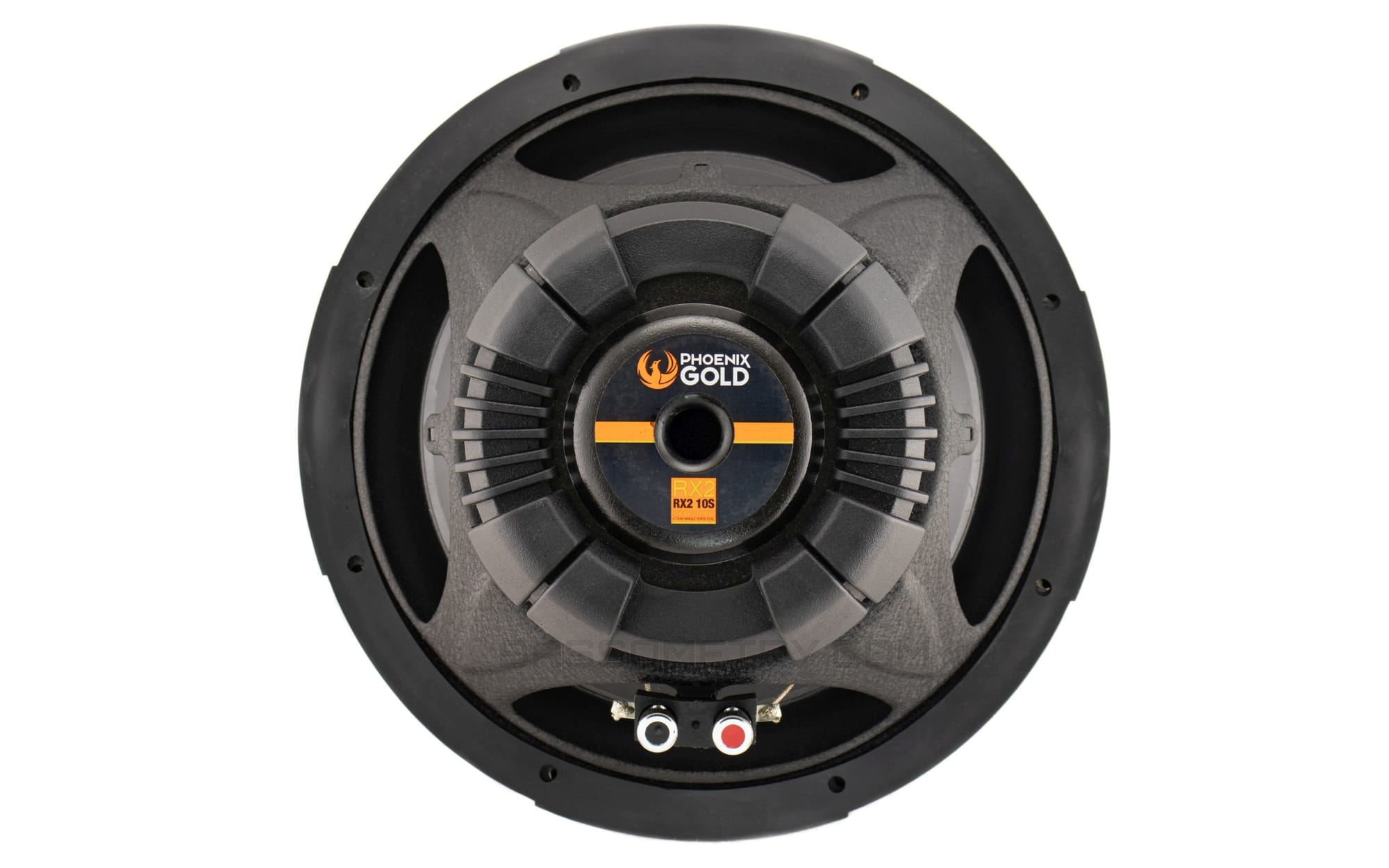
Under the hood, there is "full five waves long" spider, about 5" in diameter, centering a 2" voice coil. Straight out of the box, suspension seems to be very soft. Even so, the driver shows fair resistance to lateral (sideways) forces, suggesting decent resistance to cone rocking. Excessive softness though shows some benevolence on cone control still. By hand push, I was not able to bottom out the driver, so bottoming out is unlikely, unless damaging amounts of power is pushed into it.
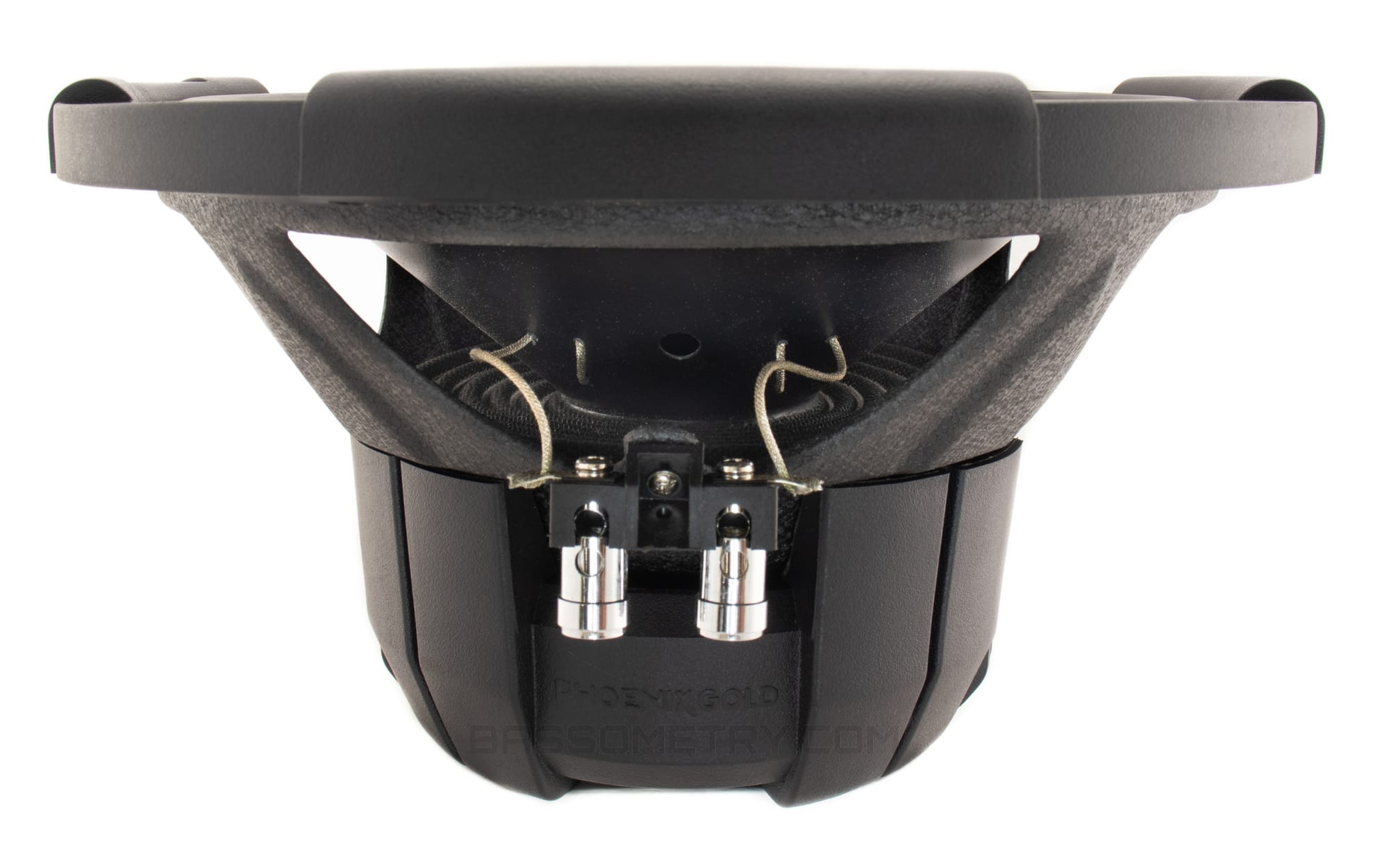
The cone features four ventilation holes and connects directly to the spider. The 12-gauge (~2.5 mm²) tinsel leads are freely woven into the cone and terminate at push-style terminals. All in all, there’s nothing here to objectively dislike. This is a well-executed driver, especially for its class.
Driver specs:
- Size: 10" type
- Power Handling: 200W RMS
- Impedance: 4 Ohm
- Frequency Response: N/A
- Sensitivity: 85.9 dB (1W/1m)
T&S parameters set:
| Parameter | Manufacturer Specs | Measured Value |
|---|---|---|
| Re [Ω] | 3.4 | 3.45 |
| Fs [Hz] | 28 | 32.0 |
| Sd [cm²] | 360 | 343 |
| Bl [Tm] | 12.2 | 13.6 |
| Qms | 6.6 | 5.8 |
| Qes | 0.35 | 0.49 |
| Qts | 0.33 | 0.45 |
| Le [mH] | N/A | 1.25 |
| Cms [um/N] | 210.9 | 187.7 |
| Mms [g] | 141.4 | 131.5 |
| Spl [dB/1W/1m] | 85.9 | 84.98 |
| Xmax [mm] | 12.5 | 11.5 |
Note: The measured Xmax value was slightly adjusted (downgraded) based on observed instability in cone control near the manufacturer-rated limit. The issue was less prominent in actual deployment on music content, but rest assured that such issue easily can spill outside the lab test conditions.
The driver was used and tested heavily. After purchase, Qes was under 0.4, but after the abuse, some parameters clearly shifted.
Performance evaluation and rating:
Thanks to light cone assembly, loose suspension and low Q values, this driver can provide majestic bass, that fills the car or mid sized room. I worked this driver in a ~23l / 0,8cu.ft 34Hz tuned ported box, and the acoustic outcome was well above being fair. It´s a likable speaker by its strong sound signature in the deepest bass region. Though, not with some of its significant shortcomings:
| 🎯 Performance | 💰 Displacement/dollar score |
|---|---|
| 27,4% | 74,4% |
- Buy if: You want great looks, great material quality, sound from low volume enclosure on a budget and don't plan on punishing the driver heavily.
- Skip if: You’re after high strain/SPL applications.
*The following section is available to Bassometry members only.* (Free sample):
Large Signal Performance Results:
| Test Element | Unit | Value | Rating |
|---|---|---|---|
| Resonance frequency shift at Xmax | [%] | 42.3 | 46% |
| Impedance shift at Xmax | [%] | 45,1 | 41% |
| Cone DC offset at Xmax | [mm] | 12.3 | 0% |
| Cone DC offset at Xmax | [%] | 185 | 0% |
| Power draw at 15Hz | [W] | 9.24 | 100% |
| Power draw at 40Hz | [W] | 146 | 20% |
| Power draw at 50Hz | [W] | 301 | 0% |
| THD 15Hz Xmax | [%] | 5.3 | 67% |
| THD 50Hz Xmax | [%] | N/A | 0% |
| Xmax behavior | 0-5 | 0 | 0% |
| Total erformance score | [%] | 27,4% |
Resonance frequency shift of 42,.3% and Impedance shift at Xmax of 45.1% are somewhat high, indicating poor cone control. That is somewhat understandable for almost any driver with loose suspension.
DC cone offset:
Maxing out at 12.3mm and 185%, this one failed with flying colors. What happened?
Parameters across the board collapse under high-level signals when approaching the claimed Xmax. As it stands, the driver couldn’t even sustain operation at 50Hz when pushed close to its specified Xmax
This is a clear example of the “Spec Overreach Trap”—where pushing specs beyond what the hardware can handle ends up doing more harm than good, setting unrealistic expectations that ultimately undermine the driver’s performance. If the Xmax was realistically lowered to around 10mm, the results would be far more favorable.
15Hz behavior:
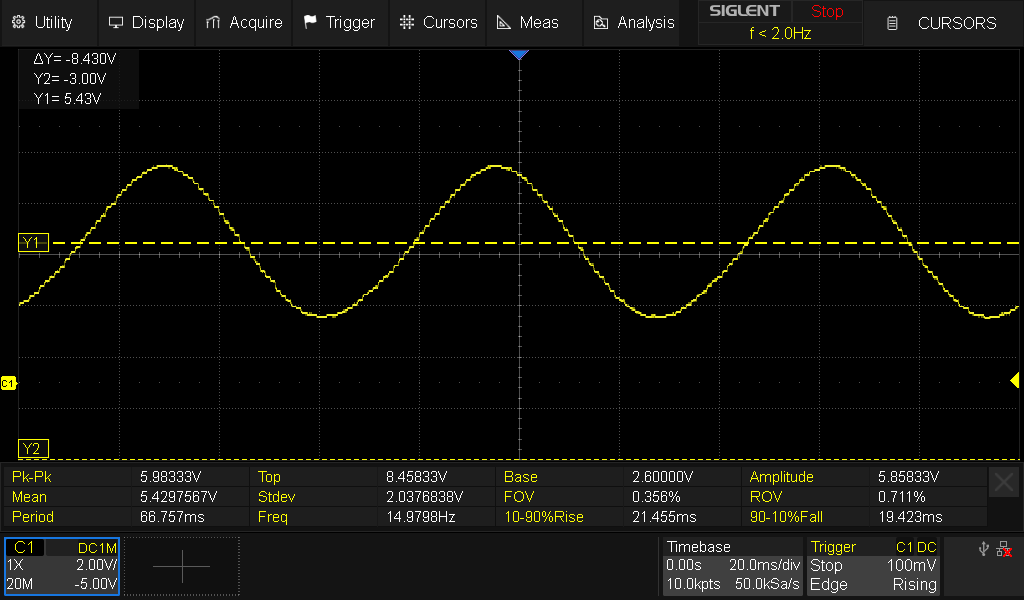
With a laser distance probe voltage span of 10.0V, and 5V offset for static-zero cone position, we see ~0,43V center position drift, translating into ~1.8mm of frontward offset at 15Hz at Xmax. One could say, this is respectable outcome for an entry level driver.
35Hz behavior:
While normally I do not provide test results at this frequency, I thoroughly sweep every unit under test across the whole range from 15Hz to 80Hz, to fish for inconsistencies and failure points. I can say now, that I found some:
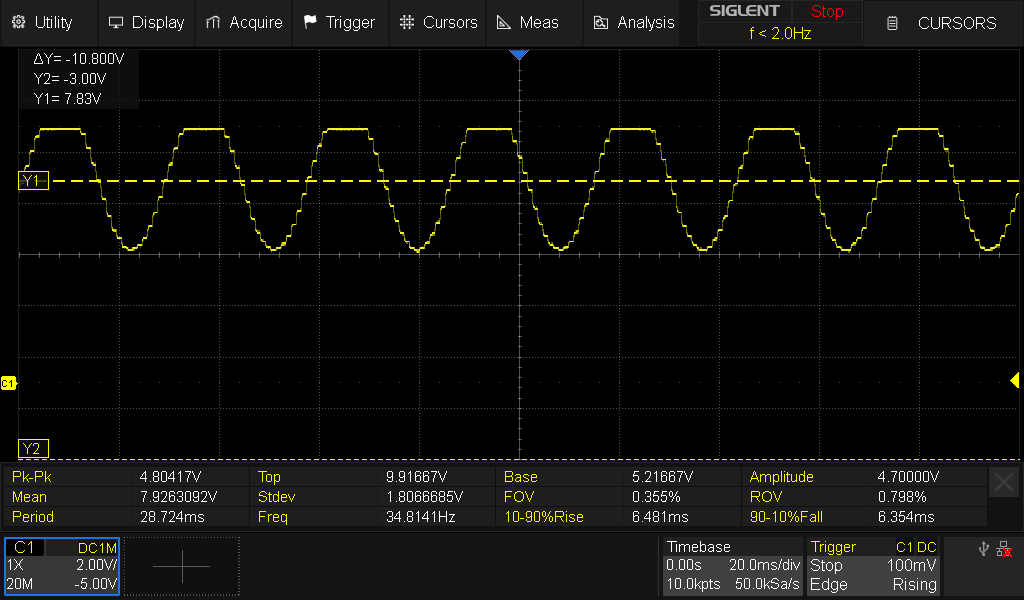
At 35Hz, with Xmax worth of excursion, the offset is almost exactly that value - 12.3mm forward offset !!! causing some nasty distortion sounds and heat strain on the driver. Few seconds of this madness, and I can already smell the hell the driver heads into. My lower-level calibrated laser probe piece for up to 22mm one way measurements even could not catch that in detail, limiting at the forward stroke - I needed to offset the probe manually just to check and confirm the displacement figure.
50Hz behavior:
Unfortunately, I was not able to conduct 50Hz Xmax test, as power input figures greatly exceeded 150% of specified value by the manufacturer, indicating the noncompliance with the known smell again. Until that point, the offset reversed to the inward direction, with same amount of the offset as input signal displacement value.
61Hz behavior:
I continued fishing further in the bass range:
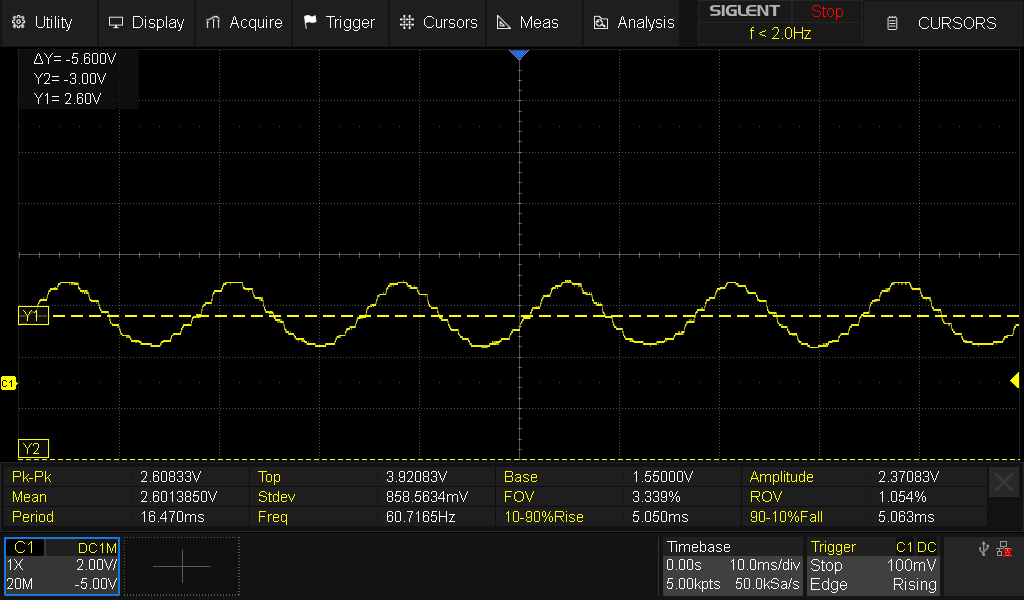
No, Just no! God, no! Offset is now 10.9mm inwardly, on the signal stimulating the driver with 5.5mm of excursion one way. The offset is now almost double the signal?!!
Power draw tests:
At 15Hz, thanks to the loose suspension, we can see only 9.24 Watts of power draw. Such an efficient air mover for bass!
At 40Hz, where acoustical impedance kicks in a bit, there is a substantial hike into 146Watts, nearing the speaker limits already.
At 50Hz, The driver cannot sustain itself, eating over 300 Watts before I even reach the Xmax. I did not get to that, for expected coil smell after several seconds of testing. The driver will not sustain itself to Xmax at this frequency. If your next purchase idea is to get something that can show few trick and stunts, maybe just SPL burp for giggles, this is not the driver to try.
THD figures:
I will be measuring mechanical THD by the laser distance probe. At 15Hz, Suspension behavior and linearity is usually revealed very strongly, and the distortion figures are usually ugly. With fairly "long" soft suspension, the RX2 10S behaved fairly admirably, at 5.3 percent points. At 50Hz though, the test could not be conducted, as again - the driver was not able to get there even. Most probably, the figure would be good.
Xmax behavior:
Unfortunately, in the case of this unit, no meaningful Xmax behavior data could be recorded. During testing, the driver was unable to maintain operation at its own specified Xmax, failing under standard large-signal conditions well below our testing threshold. Due to this, the driver could not complete the compression and overload benchmarks I will normally report in this section.
This result points not to a bad-sounding product, but to a mismatch between the published specifications and the driver’s actual large-signal performance capabilities. For fair evaluation and to prevent damage, we do not force tests beyond safe operational limits when the unit clearly cannot sustain them.
Reconciling the Numbers with Subjective Experience
The first review is already a great exercise. While this score may seem harsh, it reflects the driver’s real-world limitations under rigorous lab conditions. The RX2 10S is, by many accounts, a “lovely driver” to listen to — but our tests reveal it struggles significantly when pushed to its specified limits.
This highlights an important point: quantitative lab tests still don’t capture the full picture. Some drivers have character or tonal qualities that make them enjoyable, despite technical shortcomings, and there is no space for description of such properties. However, from an engineering and performance standpoint, these limitations do affect longevity, distortion, and overall capability.
Conclusion:
As a result, the RX2 10S scores lower in objective ranking, which might impact purchasing decisions if buyers focus solely on numbers. Yet, for those who appreciate its sonic qualities and use it within moderate limits, it could still be a worthwhile choice. Overall, the driver fails to deliver at manufacturer´s specifications.
#Car audio ; Subwoofer ; PhoenixGold ;
